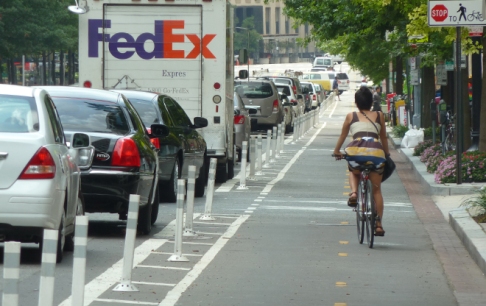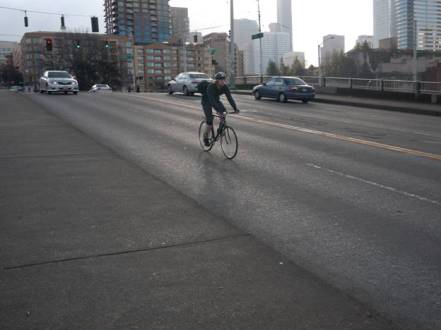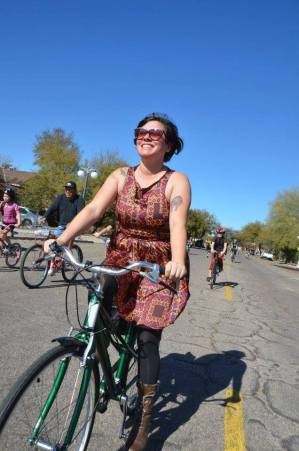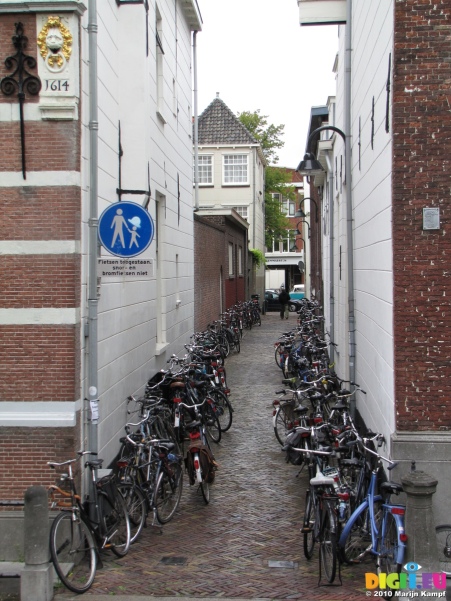Vehicular Cycling (VC) is a theory that is supported by a group of cyclists that are against any form of separated bicycle infrastructure. Their theory is based on the premise that bicycles are “vehicles” and therefore should act as a vehicle, using the car lanes just like cars. This theory appeals to very few cyclists. Although, it is common place to have to act as VC from time-to-time, especially in the U.S where seperated bike lanes are not politically or financially supported. This VC theory is also referred to as Effective Cycling and you can read that “Effective Cycling is Safer, Faster, and More Fun!” on the website of the theory’s founder, John Forrester.
The VC theory is rather striking in comparison to the bicycling philosophy that is found in the Netherlands. Holland has created a world-class bike and pedestrian network that is founded on the separation of the car from the bicycle. Considering the five Sustainability Safety Principles – separation of bicyclists through the use of cycle tracks prevents car/bike collision by reducing the vulnerability of the bicyclist, separation of uses allow for both car and bike users to have predictability on the road and allow for travel speeds to be maintained more efficiently, and perhaps most importantly, Holland has created spaces in which all road users feel safe. “These objectives are realized through a proactive approach to traffic planning that recognizes the physical and psychological vulnerabilities of a road user.”
What is striking is the fact that unlike in the United States, the Netherlands clearly puts the safety of bicyclists as a major concern within their street network designs. A bike is fundamentally different from a motorized vehicle and should not be mixed in the middle of major roads where vehicles reach high speeds. As indicated in the book City Cycling (pg 110), the Dutch Design Manual offers a set of guidelines for bicycle facilities as they relate to road speeds. Most noticeable is the fact that on streets over 50km/h (31 mph) a cycle tracks are the preferred infrastructure type. In comparison the FHWA , which also offers guidelines associated with road speeds, but rather encourages shared road options – many of which leave the bicyclists in vulnerable and uncomfortable situations.
While VC supporters still exist, they only represent a small portion of bicyclists in the U.S. From the decades of successful protected bike lanes across Europe, to the recent study, Lessons from the Green Lanes: Evaluating Protected Bike Lanes in the U.S., it can be stated that ridership increases with the installation of the protected bike lanes. However, national levels of cycling in the U.S. remain low compared to international peers. Is this because our policies do not support the separation of uses? There are many other factors that could be attributed to these low levels of cycling as well- the failure to recognize the bicycle as a viable transportation option, our lack of federal and state policies that promote and fund safe infrastructure, the cultural stigma(s) that are associated with the bike, and lastly, as demonstrated, the cultural and political contradictions that can be found between car drives, VC supporters, and advocates for safe and separated bike lanes.
In summary, the Netherlands supports the separation of bikes from vehicle traffic because speed and traffic volume affects the safety of bicyclists. While VC supporters see the shared road as the most efficient in terms of speed to get from one destination to another. There is a clear dichotomy between users who care more about speed and those who care more about separation and safety.

Cycle Track – Baltimore
Side note:
In a related blog, this author talks about his personal change from a ‘vehicular cyclist’ to a supporter of separated lanes…
http://bikesd.org/2014/06/guest-post-notes-from-a-new-long-beach-resident-michael-sullivan/


